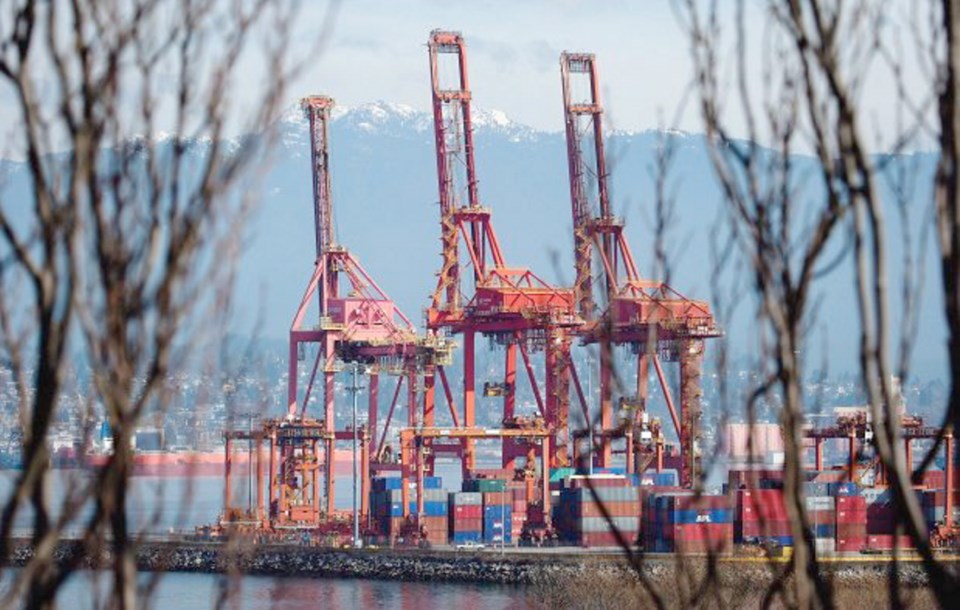Port Metro Vancouver container terminals are seeing a spike in the number of shipping containers landing at their docks as shipping lines hedge their bets against a potential labour disruption at United States ports.
The Pacific Maritime Association is in tough negotiations with the International Longshore and Warehouse Union, which represents some 20,000 longshoremen at 29 U.S. west coast ports, from the giant terminals at Los Angeles and Long Beach to the tiny port at Anacortes, Washington.
Talks are expected to go past the June 30 expiry date of the union’s last contract, and while the sides have committed to negotiate until they have a deal, memories of past labour disruptions have shippers moving to diversify their supply-chain routes.
“What we are seeing is (that) some shippers are certainly hedging their bets,” by directing more cargo to other ports, said Stephen Brown, president of the B.C. Chamber of Shipping. That includes directing more traffic to U.S. east coast ports as well as “guide a bit of a spike” in movements through Port Metro Vancouver.
“It goes back to 2002,” Brown added, referring to a lockout that shut down the U.S. terminals.
“People remember that, so they don’t want to get caught again,” Brown said.
Lengthy negotiations are par for the course in the industry, judging by previous rounds of bargaining in 2008 and 2002. In 2002, negotiators didn’t reach an agreement until around Thanksgiving, following an impasse that led to a 10-day lockout.
However, that disruption, which cost the U.S. economy an estimated $1 billion per day that it lasted, had a lasting impact on shippers and retailers that have become accustomed to just-in-time-delivery supply chains.
“They can’t afford to have their goods hung up either out on the sea or on the docks,” said Jonathan Gold, vice-president of supply chain and customs policy at the National Retail Federation.
Worried that any one route will become a bottleneck, they’ve looked to the Gulf Coast, east coast and Canada, in some cases courted by ports with upgraded facilities.
“Shippers often come to Port Metro Vancouver as an aspect of their supply-chain diversification,” said Jennifer Hunt, a spokeswoman for the port authority. “So they’re always looking to see what we can accommodate.”
Port Metro Vancouver moved 2.8 million 20-foot-equivalents worth of containers last year, an increase of four per cent from 2012.
And Port Metro Vancouver has its own labour unrest that is still on “high simmer” with container truck drivers.
Canada’s biggest port was slowed to a crawl when truck drivers went on strike for 28 days in March, and union spokesman Gavin McGarrigle said they are now having difficulties getting trucking companies to comply with measures in the resolution.
At the Port of Prince Rupert, traffic over the past couple of months has increased to levels its container terminal last saw in 2012, according to Shaun Stevenson, vice-president of trade development and public affairs. However, he added that it is hard to judge what will happen in the coming months.
“I think (the potential for labour disruption) has been on North American shippers’ minds for over a year now,” Stevenson said. “So I don’t know that we expect anything specific over the next several weeks.”
Stevenson added that the diversification of trade lanes to key distribution hubs has been one of the reasons for Prince Rupert’s success since it opened in 2007. The Prince Rupert terminal is not operating at full capacity but he noted that customers “are always adjusting their selection of gateways and corridors based on how well we’ve performed over the past six to 12 months.”
On the American side, West Coast ports handled $892 billion worth of cargo in 2013 alone, according to trade data compiled by the U.S. Census Bureau.
However, Brown said B.C. ports would have limited opportunities to pick up a lot of extra traffic in the event of a labour disruption south of the border.
He said that shipping lines would be able to move some additional containers to the ships on the Vancouver route, but wouldn’t be able to divert ships that normally only serve U.S. ports. They would likely be declared off limits by the ILWU’s Canadian members.
Brown added that B.C. terminals that are already busy would have limited capacity to take additional containers. In California, the ports of Los Angeles and Long Beach combined handle more than 11 million twenty-foot-equivalent units worth of containers.
With files from The Associated Press



